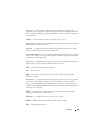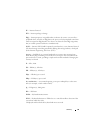
92 Glossary
group — As it relates to DMI, a group is a data structure that defines common
information, or attributes, about a manageable component.
guarding — A type of data redundancy in which a set of physical disks stores data and
an additional disks stores parity data. See also mirroring, striping, and RAID.
h — Hexadecimal. A base-16 numbering system, often used in programming to
identify addresses in the system’s RAM and I/O memory addresses for devices. In
text, hexadecimal numbers are often followed by h.
headless system — A system or device that functions without having a keyboard,
mouse, or monitor attached. Normally, headless systems are managed over a network
using an Internet browser.
host adapter — A host adapter implements communication between the system’s
bus and the controller for a peripheral device. (Disk controller subsystems include
integrated host adapter circuitry.) To add a SCSI expansion bus to your system, you
must install or connect the appropriate host adapter.
hot-pluggable — The ability to remove a system component or attached device
without powering down the system. While a component may be "hot-pluggable," you
should never remove a component or device while data traffic is occurring that
involves the component. For more information, see the documentation for your
specific component or device.
Hz — Hertz.
I/O — Input/output. A keyboard is an input device, and a monitor is an output
device. In general, I/O activity can be differentiated from computational activity.
ID — Identification.
IDE — Integrated drive electronics. A standard interface between the system board
and storage devices.
integrated mirroring — Provides simultaneous physical mirroring of two drives.
Integrated mirroring functionality is provided by the system’s hardware. See also
mirroring.
internal processor cache — An instruction and data cache built into the processor.


















